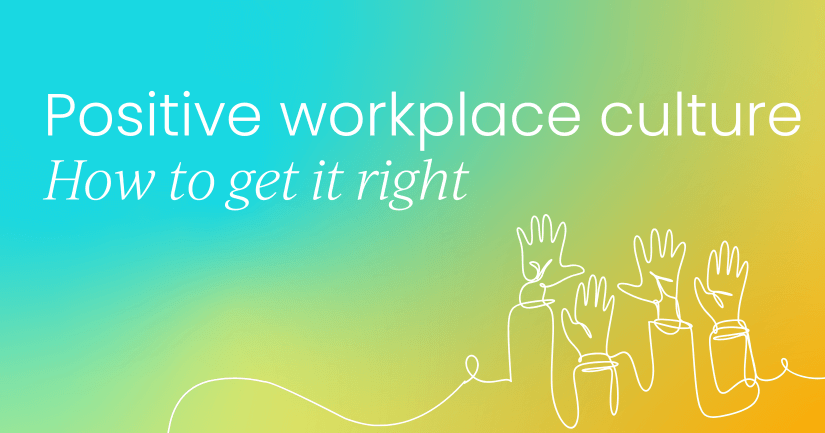More employees are leaving their jobs, and it's not only about money or promotions. A staggering 61% of employees say they’d leave their current role for a company with a better workplace culture. This isn't just a statistic, it's a loud and clear message from the modern workforce.
But what does it mean?
Well, it shows how much culture in the workplace influences loyalty, performance, and reputation. For employers, it’s no longer about offering perks to keep employees happy - it’s about creating a workplace where people actually want to be.
Building a positive workplace culture isn’t just good for morale - it’s a strategic advantage. If your company has a good culture, people stay, teams work well, and others want to join.
This guide breaks down the key components of a positive workplace culture. You’ll also learn about the growing importance of cultural fit, the cost of getting it wrong, and how high-performing companies get it right.
Table of contents:
- What is workplace culture?
- Why it's important
- Types of workplace culture
- Elements of a positive workplace culture
- Benefits of positive culture in the workplace
- Toxic vs positive corporate culture
- How to build a positive workplace culture
- Cultural diversity in the workplace
- Assessing culture (metrics)
- Workplace culture in a remote or hybrid work environment
- Positive workplace examples (mini case studies)
What is workplace culture?
Workplace culture refers to the overall atmosphere and environment at work. It’s the everyday habits, values, and unspoken rules that shape how people act, talk to each other, and do their work.
A lot of people assume it’s mainly about company perks or even office layouts. However, it’s more about the ‘vibe’ of the team, the tone of leadership, the way decisions are made, and even how people handle mistakes or celebrate wins.
You can tell a lot about a company’s culture in how new ideas are welcomed (or not), how feedback is given, and how safe people feel speaking up.
Culture in the workplace starts with leadership. How leaders communicate, set expectations, and respond under pressure sets the tone for everyone else.
But culture doesn’t live in the C-suite alone - it’s shaped by the people on the ground, too. The stories they tell, the habits they form, and what they reward or challenge all contribute to building a positive workplace.
Culture is built (or broken) in the little moments.
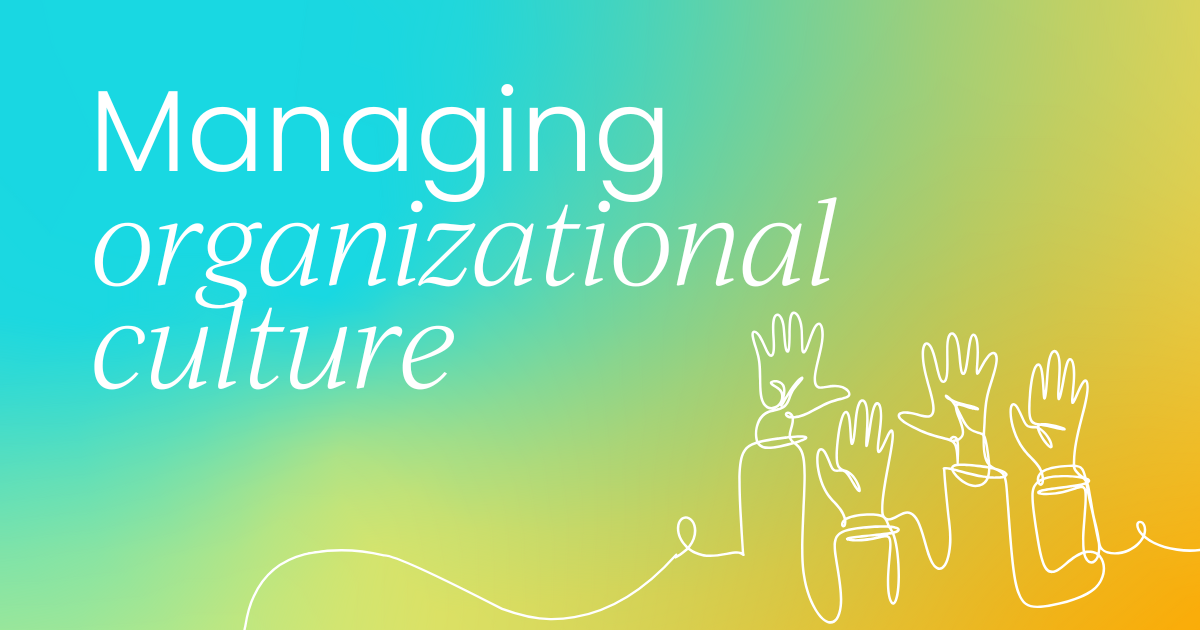
Why workplace culture matters
A company’s culture is important because it affects how people work, how they collaborate, and ultimately, how well the organization performs.
When the culture is strong, clear, and aligned with the company’s values, employees tend to be more engaged, loyal, and productive.
Don’t believe us? Let’s look at some data to back this up…
According to Gallup, companies that prioritize workplace culture see a 33% increase in revenue compared to those that don’t. This proves that building a positive workplace culture can give you a real competitive advantage.
Executives are starting to see the connection, too. In one recent survey, 92% of business leaders agreed that building a strong company culture is crucial for organizational success.
What happens when culture goes wrong?
Toxic cultures come with real costs. They erode trust, fuel disengagement, and are one of the top reasons people leave their jobs.
Over 63% of U.S. companies now say it’s harder to retain employees than it is to hire them. That’s not just a hiring challenge, though, because it also reflects how much workplace expectations have changed. People aren’t simply chasing job offers like they once did. Nowadays, they’re looking for purpose, respect, and a culture that supports them. If that’s missing, they’re more than willing to move on.
What this tells us is that attracting talent is no longer the hard part; keeping them is. And if the culture isn’t strong, supportive, and aligned with what people value, even the best recruitment strategy won’t keep people around for long.
Types of workplace culture
While every company has a unique dynamic, most workplace cultures tend to fall into a few broad categories. These were defined back in the 1980s when organizational scholars Robert E. Quinn and Kim S. Cameron developed the Competing Values Framework (CVF) to help companies understand and assess their cultures.
This model shows four main types of workplace culture:
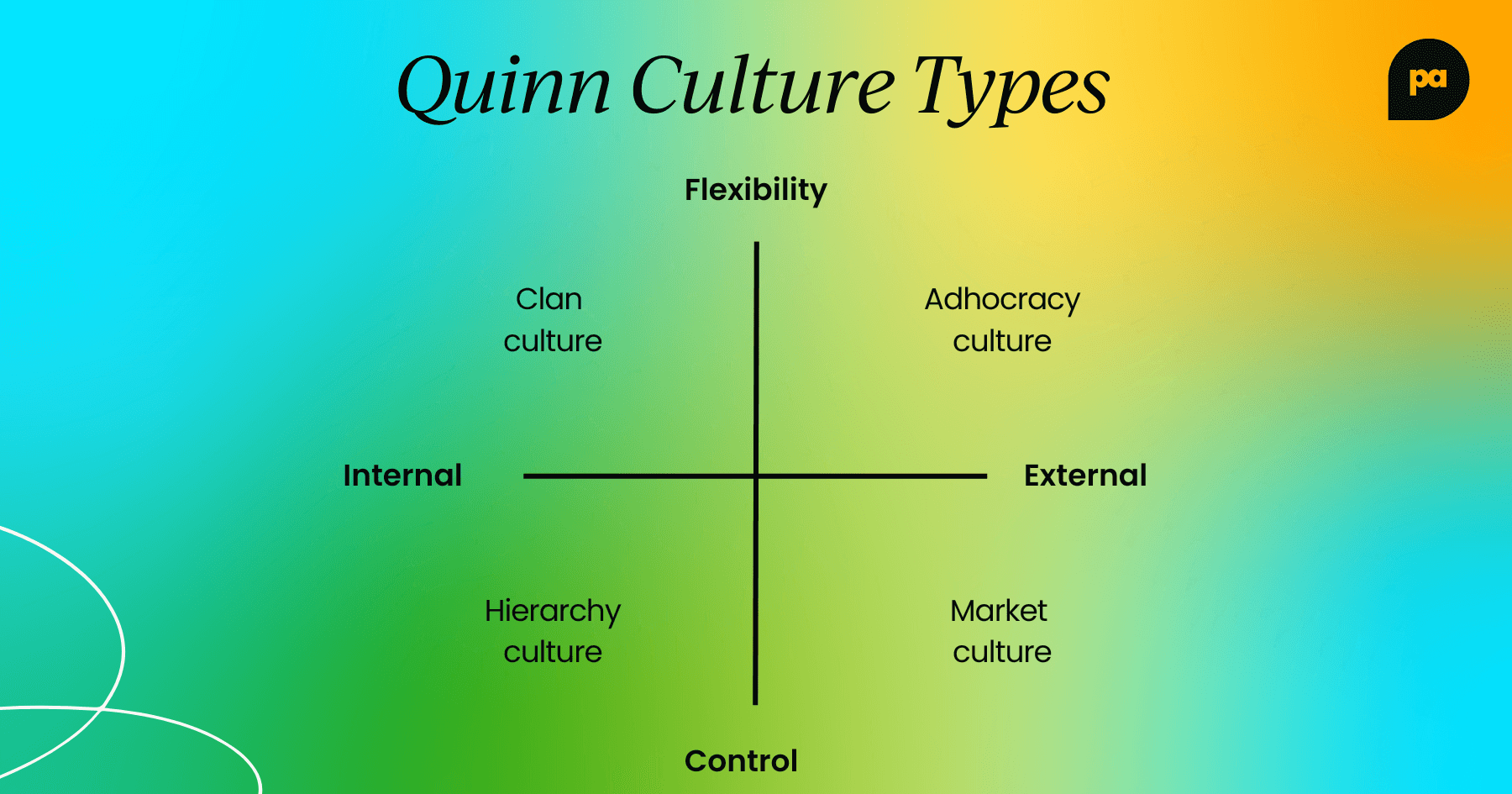
A lot of companies and HR teams find this framework very useful. So, let’s go over each section in more detail to help you better assess your current culture and make the right moves toward building the one you want:
1. Clan culture
You can spot clan cultures by their friendly and collaborative work environment. Employees often talk about having a strong sense of belonging in such workplaces, and there is a strong emphasis on:
- Leaders acting as mentors or coaches
- Teamwork
- Participation
This type of culture in the workplace values loyalty, tradition, and a strong commitment to employee development.
2. Adhocracy culture
Fast-moving, creative, and experimental - adhocracy cultures thrive on innovation and adaptability.
This type of workplace culture values:
- Creativity and innovation
- Leaders who are visionaries
- Taking risks
The adhocracy culture tends to focus on pushing employees to think outside the box. Although this kind of thinking can lead to breakthrough ideas, it also requires a certain tolerance for failure and change.
Start-ups and companies in highly competitive, tech-driven industries often fall into this category.
3. Market culture
Market cultures are all about:
- Driving results
- Measuring success by performance
- Competitiveness and achievements
Leaders are usually hard-driving and demanding, focusing on winning and achieving measurable goals. Success is defined by market share, profitability, and goal accomplishment.
This kind of culture can be motivating for high achievers, but may feel intense for others.
4. Hierarchy culture
Leaders in a hierarchy culture are good at planning and keeping things organized. They care about working efficiently, staying steady, and following rules. Success is usually measured by dependable delivery, smooth scheduling, and low cost.
Hierarchy cultures prioritize:
- Structure
- Formal rules
- Procedures
There’s a strong chain of command, and decisions often follow established procedures. While this culture may lack flexibility, it can offer security and predictability.

Can organizations have a hybrid culture?
Absolutely, and many do. Few companies fit neatly into just one category. You might have a collaborative, clan-style team inside a broader company that operates more like a hierarchy. Or a start-up may blend the fast pace of an adhocracy with structured market goals.
Hybrid cultures work best when they're built on purpose, not just something that happened by accident. When you've got mixed messages or fuzzy expectations floating around, that's when things start to feel disjointed and confusing for everyone. It's about being deliberate.
Elements of a positive workplace culture
We all know that creating a positive workplace culture is important, but what does that actually look like?
Below, we explore the core elements of a positive workplace culture. Each of these elements is consistently found in high-performing, people-centric organizations:

Trust and transparency
Deloitte’s 2024 Global Human Capital Trends report revealed that 84% of leaders say that the more transparent the organization is, the greater the workforce trust.
But what does transparency in a work setting actually look like?
It can take the form of things like good communication from leadership. This could be as simple as leaders sharing updates on company performance, goals, and challenges. It could also take the form of involving the rest of the team in big decisions like restructuring or strategy shifts.
That’s just one example of how a company can be more transparent. Some other examples include:
- Easy access to information.
- Feedback isn’t just gathered, it’s acted on.
- Managers are upfront about goals, expectations, and how performance is measured.
- Job descriptions and internal roles are shared company-wide.
- There's openness about DEI goals and representation data.
- There's a commitment to honest updates rather than vague corporate-speak.
When trust is high, compliance, engagement, and retention naturally follow. HR plays a key role in promoting open communication channels and modeling honest feedback loops.
Open communication
Cultures thrive when communication is two-way, frequent, and authentic. That means leadership that listens, teams that share freely, and systems that don’t just collect feedback but act on it.
For HR, this means investing in the tools and practices that make dialogue a habit, not an event.
Need some ideas to help foster more open communication? Here are some tips that might help:
- Establish regular check-ins between managers and direct reports.
- Encourage anonymous feedback (try surveys or even suggestion boxes).
- Host ‘Ask me Anything’ (AMA) sessions and give the team direct access to leadership for questions.
- Train managers on how to truly listen and respond.
- Explain the 'why' behind company choices.
- Break down silos by encouraging interaction between teams.
Employee recognition and appreciation
A culture that celebrates wins (big and small) creates a sense of purpose and momentum. A good way to move this along is by championing both formal programs and informal practices that spotlight effort, impact, and progress.
Not everyone wants appreciation in the same way. While some team members like public praise, others prefer a quiet thank you. If you can tailor how you and/or managers show appreciation, your team will be much happier.
Don’t forget to celebrate progress, not just big wins. Recognize effort, improvement, or collaboration along the way, especially in long-term or behind-the-scenes work.
💡 Tip: When possible, link praise back to a core value or mission. This reinforces culture and gives the recognition deeper meaning.
Example: “Your support for the new hire this week really embodied our value of ‘Lift Each Other Up.’”
Respect and inclusion
Inclusion is about making sure every employee feels seen, heard, and valued. Respect shows up in everyday behaviors: who gets the mic, how decisions are made, and whether differing voices are welcomed.
This isn’t just a social priority, it’s a hiring one. According to YouGov, 66% of UK workers say acceptance and inclusion of employees from all backgrounds is important when they’re looking for a job. That means your culture isn’t just influencing the people who work there now, but it’s also shaping your ability to attract future talent, too.
Real inclusion takes clear plans, support from leaders, and the bravery to challenge old habits. For HR, this means using inclusive steps in hiring, promotions, teamwork, and problem-solving. Remember, it's not all about tracking diversity numbers!
Work-life balance
CIPD’s Good Work Index reported that 1 in 4 workers (25%) agree it is difficult to fulfill their commitments outside of work, because of their job. That's a significant portion of our workforce feeling squeezed and struggling to maintain a life beyond their professional duties.
For people leaders, this statistic reveals red flags that could point to burnout and stress. When work makes it hard for employees to manage their personal lives, it can hurt their well-being. Over time, this lowers morale and makes them less loyal to the company. This isn't just about individual stress, it permeates the entire culture.
Psychological safety
Research carried out by Mind UK found that 57% of employees have experienced poor mental health while working for their current employer. This isn't just a concern for individual well-being; it's a profound cultural issue that highlights a fundamental lack of psychological safety in many organizations.
When most employees have mental health problems, it may mean the workplace doesn’t feel safe. People might be afraid to speak up about stress, unfair treatment, or a toxic environment.
Without psychological safety, people don’t feel safe to speak up. They worry about being judged or punished, so they stay quiet and keep problems to themselves.
Without psychological safety:
- Employees bottle up stress, leading to burnout and anxiety.
- They might fear judgment or negative repercussions if they disclose mental health challenges.
- They may hesitate to ask for help or suggest improvements that could alleviate stress.
- The pressure to appear constantly 'fine' or 'on' contributes significantly to mental health decline.
To avoid this, try to create an environment where employees feel safe to speak up, ask questions, admit mistakes, and take risks without fear of negative consequences.
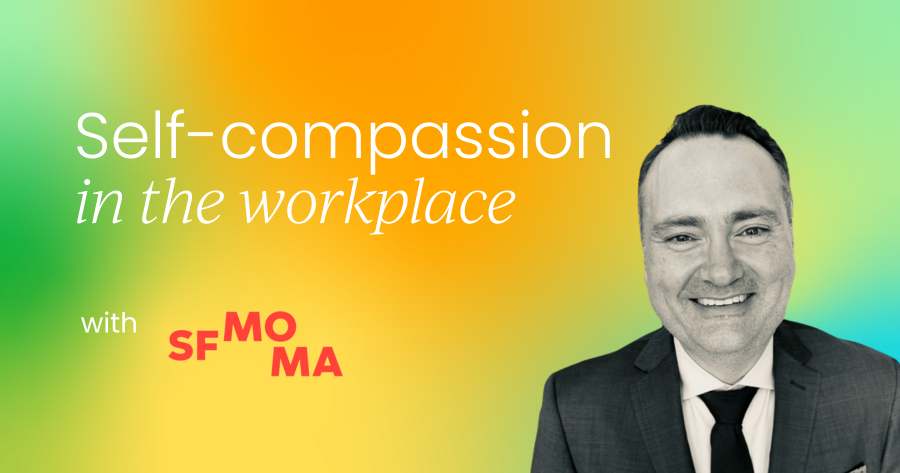
Benefits of positive culture in the workplace
Culture is no longer just an HR issue; it’s a business-critical advantage. The way people feel at work directly impacts how they perform, how long they stay, and how they talk about your company when they leave.
A good culture helps people stay involved and come up with new ideas. A bad culture slowly lowers team spirit, loses good workers, and hurts results.
Here’s why culture matters more than ever:
Higher engagement and retention
When employees feel respected and valued, they're more likely to stay. This helps attract even more great people to your team.
But, culture can also be the reason an employee exits for good. 45% of employees cite a toxic work environment as their primary reason for quitting. And for job seekers, a healthy culture isn't a perk, it's a priority, with 88% considering it vital for success.
Boosted productivity
Engaged employees don’t just stick around - they perform better. Research from The University of Warwick shows that satisfied employees are 12% more productive than the average worker. A positive culture creates the conditions for people to do their best work.
Improved reputation and talent attraction
Like news, culture travels fast. Companies with strong cultures stand out in the job market and build trust with candidates before the first interview. That reputation also translates to stronger employer branding and more qualified applicants.
Less burnout and absenteeism
Organizations with a people-first culture tend to see lower levels of stress, burnout, and unplanned absences. When employees feel supported, they’re more resilient and more likely to take care of their mental and physical well-being.
A competitive advantage
Culture is one of the few things that can truly make your company stand out. It affects how fast teams adapt, how well they work together, and how loyal employees are. All of this has a big impact on how the company performs and grows.
Toxic vs positive culture in the workplace
Here’s how a toxic culture compares to a healthy one, and why getting it right makes all the difference.
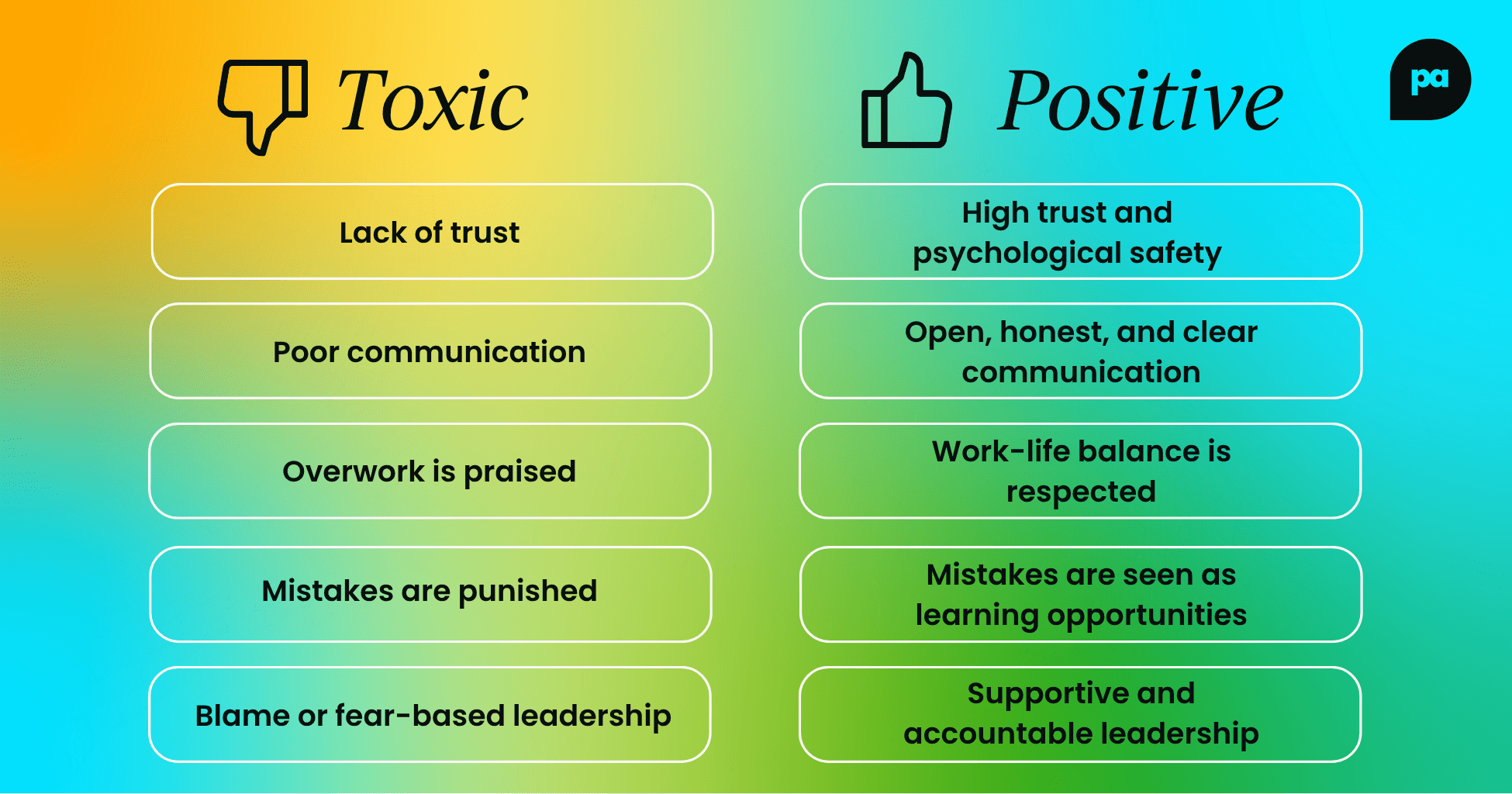
How to build and maintain a positive workplace culture
A compelling 69% of Gen Z employees actually prefer a positive company culture over a higher paycheck.
Do you find this hard to believe?
Many people feel this way, which shows that what today’s workers care about has changed, especially among younger employees. Because of this, building a positive workplace culture is now a big priority for both HR and company leaders.
So, how do you create a culture that brings in great people, keeps them engaged, and helps the company succeed?
First, let’s take a look at the five key pillars of a positive workplace culture. We’ve already discussed these above, but they should be at the front of your mind while you’re trying to build one:
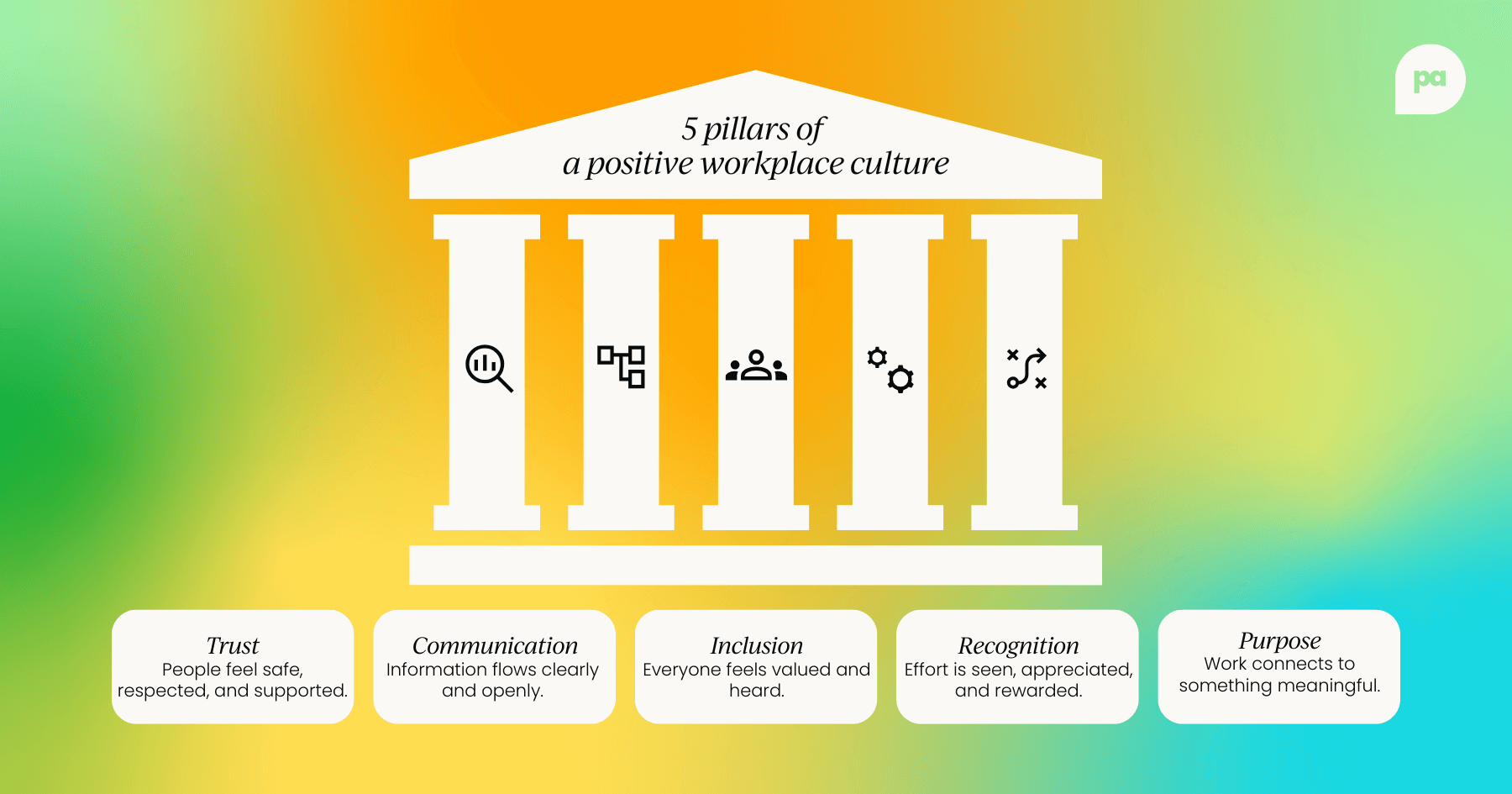
Okay, so how do we actually do this? How do we build that amazing culture where people don't just show up, but genuinely want to work and grow?
As you can see in the image above, we've put together a simple, practical framework to help HR leaders like you make it happen. We'll use these five pillars of positive workplace culture as our blueprint for action, turning big ideas like trust, inclusion, and purpose into everyday behaviors that truly make a lasting impact.
Let's get into it!
1. Trust → Lead by example + prioritize psychological safety
Trust is built (or broken) by leadership behavior. When leaders model transparency, admit mistakes, and invite honest feedback, they create psychological safety, which can be viewed as the foundation of a healthy culture.
Try these tips:
- Train managers to be approachable, consistent, and accountable.
- Encourage open dialogue, not just top-down directives.
- Implement "skip-level" meetings to provide alternative avenues for feedback and build broader trust.
- Publicly acknowledge mistakes made by leadership and outline lessons learned, demonstrating vulnerability and a commitment to improvement.
2. Communication → Communicate early, often, and transparently
Strong cultures thrive on clarity. Regular, honest communication builds alignment and reduces confusion or mistrust.
Practical tips to help you achieve this:
- Share context behind decisions, explaining the "why" and involving employees early when possible.
- Share news in different ways. For example: email, Slack channels, team meetings, or short videos from leaders.
- Create strong feedback loops that go both ways.
- Train managers to be good listeners. This helps them understand concerns and share info clearly with others.
3. Inclusion → Hire for culture add + build feedback into the culture
Inclusion is about who has a voice and how decisions are shaped. Hiring people who bring diverse perspectives (and listening to them) really strengthens culture.
Here are some ways to create a more inclusive workplace:
- Use diverse interview panels. Focus on what new ideas or perspectives a person can bring, not just if they fit in.
- Invite different team members to share ideas in meetings and planning sessions. Make sure everyone gets a chance to speak and be heard.
- Support and empower Employee Resource Groups (ERGs).
- Conduct inclusion surveys. You could also try hosting listening sessions. These will help you gather insights from underrepresented groups.
4. Recognition → Recognize and reinforce positive behaviors
What gets recognized gets repeated. Consistent, values-based recognition motivates employees and strengthens cultural norms.
Tips to help:
- Encourage peer-to-peer shoutouts using platforms like internal communication channels or dedicated recognition tools.
- Spotlight team wins and individual contributions in all-hands meetings, newsletters, and department updates.
- Integrate recognition into manager training.
- Create a mix of formal and informal recognition programs.
5. Purpose → Define your values clearly + stay flexible as you grow
People need to know what they’re working toward and why it matters. Purpose gives culture direction, but it also needs to evolve with your team and the changing business.
Some ways to increase purpose within your workplace culture include:
- Regularly aligning individual and team goals with overarching company values and mission.
- Communicating the “why” often, not just the "what”.
- Host vision-setting workshops periodically where employees at various levels can contribute.
- Revisiting and adapting your cultural values and purpose regularly.

Cultural diversity in the workplace: Why it matters
The importance of cultural diversity in the workplace goes far beyond meeting hiring goals. When teams have people from different backgrounds and experiences, they come up with better ideas.
They ask new questions, think in fresh ways, and solve problems more creatively. That’s a big advantage of cultural diversity in the workplace because it helps teams be more innovative.
But diversity on its own isn’t enough.
To get the real benefits of cultural diversity, companies need more than diverse teams. They must create a space where people feel heard, respected, and able to share their ideas.
That’s where diversity, equity, inclusion, and belonging (DEIB) comes in:
- Diversity is who’s in the room.
- Equity ensures fair access to opportunities.
- Inclusion is about whose voices are considered.
- And belonging is how people feel once they’re there.
To support all four areas, you need to make clear choices in how you:
- Hire new people
- Welcome new staff
- Train managers
- Communicate with the team
You also need to watch for hidden bias. Unintentional bias can affect who gets promoted, who joins meetings, and whose ideas are taken seriously.
Building cultural awareness in the workplace is critical for leaders and teams alike. It's not just good ethics; it's good business.
How can you assess culture?
Want to measure and assess your workplace culture? No problem. There are a range of ways you can do this using a mix of quantitative and qualitative data:
- Employee engagement surveys: These are important to gauge your team’s feelings and overall job satisfaction.
- Turnover rates: Analyze who's leaving, why, and from where.
- Absenteeism rates: Persistent absences can point to underlying stress or dissatisfaction.
- Exit interview data: Systematically collect insights from departing employees to find recurring themes.
- Internal promotion rates: A healthy culture often sees internal mobility.
- Employee referral rates: A strong sign that employees are proud of their workplace and happy to recommend it.
- Diversity, Equity, and Inclusion (DEI) metrics: Beyond numbers, measure sentiment on inclusion, fairness, and belonging across all groups.
- Pulse surveys: Short, frequent surveys give quick feedback on certain issues or changes.

Workplace culture in a remote or hybrid work environment
Remote and hybrid setups have redefined how teams connect, collaborate, and build relationships, and the data is clear: flexibility matters. 58% of employees say they would rather quit than return to full-time office work.
Companies that allow flexible work are seeing big results. They keep twice as many employees and get 30% more job applications than those requiring full-time office work.
So, how do you maintain connection and cohesion when teams are spread out?
It starts with intention. Easy things like virtual coffee chats, team check-ins, or shoutout channels help keep work feeling personal. Tools like Slack and Zoom also help teams stay connected and support company culture.
But it’s not just about tech. Leaders need to focus more on being open, fair, and inclusive. This helps remote workers feel just as connected and valued as those in the office.
The problem with fragmentation
The biggest threat to culture in hybrid environments is fragmentation. This is when remote employees feel like second-class citizens, or when information only flows in informal, in-person settings.
HR can help fix these gaps by:
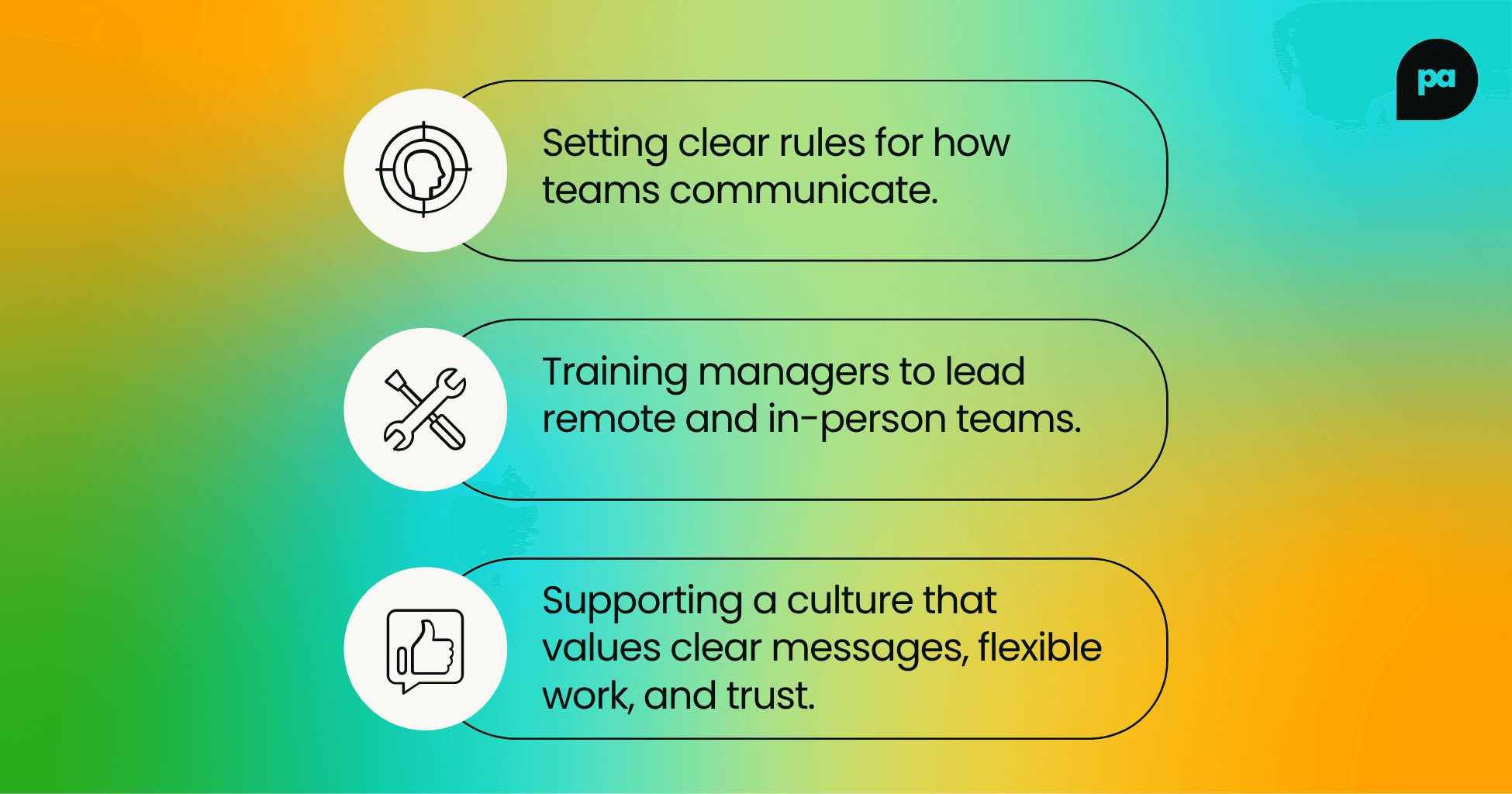
Positive workplace culture examples
Let's look at some real-life positive workplace culture examples to better understand how they’ve created environments that prioritize employee well-being, innovation, and inclusivity.
Pixar

At Pixar, psychological safety is the foundation for creativity. Instead of encouraging competition, teams collaborate, give honest feedback, and embrace early, imperfect ideas.
It's not about judging each other, it's about improving the work. By normalizing vulnerability and practicing radical candor, Pixar's team turns rough concepts into remarkable stories, together.
Tesla

Tesla is all about innovation, so it’s no surprise that they push limits and encourage employees to try new things.
They often work in small teams where everyone is responsible for their part. These teams are expected to aim high and deliver great results.
Slack

Slack’s culture is a lot like its product - open, collaborative, and all about clear communication. Everyone’s in the loop, and ideas can come from anywhere. There’s a big focus on saying things well and meaningfully, and the team is always looking for ways to communicate better, both with each other and with users.
They also take work-life balance seriously. People are expected to give their best during the day, but once it’s 6 p.m., Slack’s off-limits. No late-night pings or no weekend check-ins.
Empathy and community run deep here, too. The team is diverse and supportive, and everyone’s encouraged to pitch in and make things better for each other and for the people they’re building for.
Patagonia

One of the best positive workplace culture examples has got to be Patagonia. Patagonia was never meant to be a typical company, and that’s exactly the point. The Founder, Yvon Chouinard, set out to create something different: a business that puts people and the planet before profit. He knew that doing things the usual way wouldn’t cut it if they wanted to take care of what really mattered.
With a mission like “We’re in business to save the planet,” Patagonia backs up its words with action, embedding sustainability into every decision it makes.
Patagonia has not only built a loyal following but consistently outperformed competitors, showing that a strong, values-driven culture is more than just good ethics; it’s smart business.
To wrap it up...
Great culture doesn’t happen by accident. It’s created through trust, clear communication, inclusion, recognition, and a shared sense of purpose. The good news? Every conversation, policy, and decision is a chance to strengthen it.
Want to connect with other people leaders?
Join our free Slack community to swap ideas, share wins, and learn alongside others passionate about building better workplaces.
We’d love to have you with us. 💬🤝



 Follow us on LinkedIn
Follow us on LinkedIn




